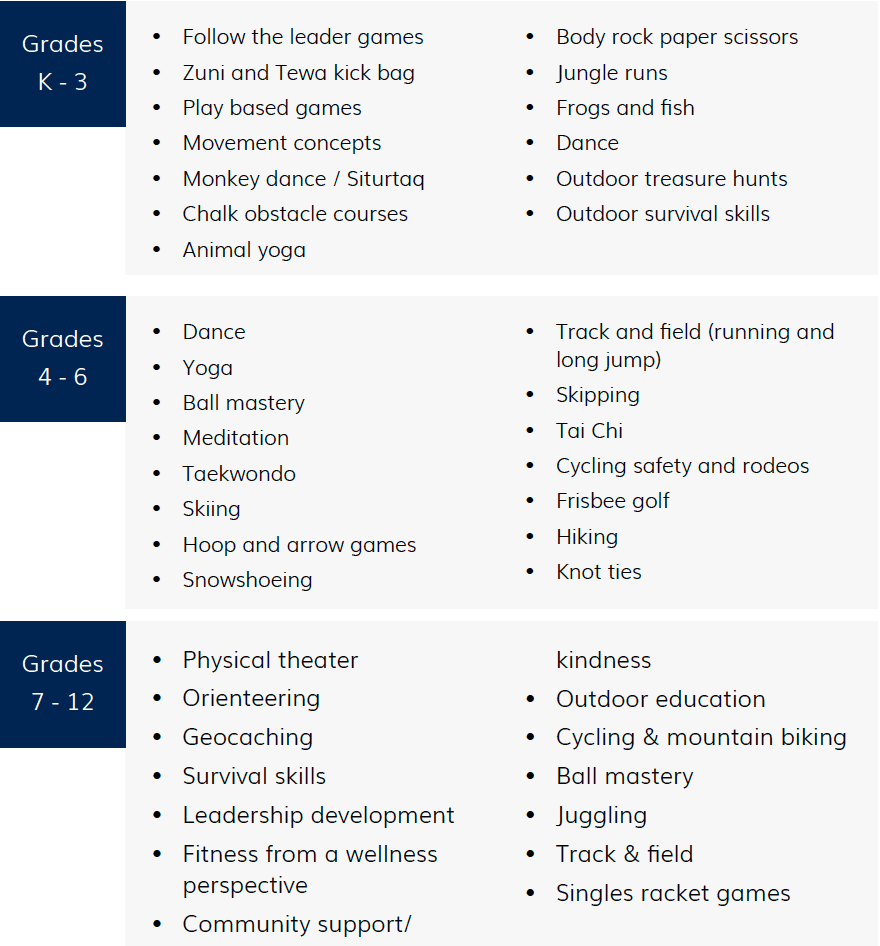
Physical Education (PE) Instructional Considerations: How do we engage our students in meaningful learning to help them connect what they are learning at school to their personal lives?
We are working in, and creating, new learning environments. As such, there are additional factors to consider. In planning for quality PE in your jurisdiction or school, consider the following instructional strategies through an equity, inclusion, and diversity lens:
Blended learning (online and in-school learning)
- Review curricular outcomes and structure your classes around the effective teaching of key expectations
- Re-think delivery models to include flexible, student-centered, blended digital and person-to-person options
- Include student voice, ideas, and perspectives in planning lessons and activities
- Analyze learning outcomes, keeping the E in Physical Education through a focus on the four domains equally - physical (move), cognitive (think), affective (feel) and behavioural (act)
- Include more individual pursuits than traditional team activities such as dance, alternative environment and land-based activities, exercises without equipment, fitness, mindfulness, gymnastics, and target games
- Explore local parks and green spaces to promote outdoor learning and activity
- Consider using flipped classrooms, inquiry-based learning, social emotional learning, trauma informed approaches to optimize learning and health and well-being
In-school learning
- Respect the physical distance of 2 metres always
- For small sided games, use visual guides to define space and ensure physical distancing is maintained
- Ensure safe, healthy equipment management
- Incorporate proper hand washing and personal hygiene routines
- If possible, create a hand washing station outside all classrooms
- Use outdoor spaces and parks as much as possible
- Modify layouts and use physical and visual guides, such as tape or ropes on floors, grass or sidewalks, and signs on walls
- Manage and practice movement through spaces
- Clearly communicate the route and rules with students ahead of every location move and transition. Review with students how the move went and how it can be improved
- Stagger scheduling to limit mixing between cohorts
- Close play structures and small communal spaces (e.g. change rooms)
Equipment & Gear: How do we ensure healthy equipment management? How do we ensure students have suitable gear for PE?
- Focus on activities that do not use equipment
- If equipment must be used
- Avoid sharing equipment by numbering and assigning each student their own supplies
- Assemble individualized PE kits that can be assigned to students
- Have students create their own PE kits to use at home or school and set aside budget for additional kits to be purchased
- Make sure the equipment has been properly disinfected after each use and not touched after disinfection
- Anticipate equipment hygiene compromises and keep extra equipment on hand so that instructional time is not lost to re-cleaning equipment
- Disinfect teaching aids (clipboards, white boards, pens, plastic bins for transporting materials etc.)
- Encourage students to come to school in clothing that is appropriate for PE and the weather conditions to eliminate the use of change rooms
- When transitioning to/from outside remind, and monitor, students to use designated areas for changing into jackets and winter clothing if moving outdoors, such as in designated desk area or a marked side of the hallway
Space: Where can PE be taught? If the gymnasium is unavailable for PE, what types of activities can be taught?
- If using the gymnasium, open the doors to maximize air flow
- Match the instructional design to the available space – use stations, marked off areas, poly spots, etc., to ensure separation among students
- Maximize outdoor time while avoiding use of permanent playground structures, benches, and walls
- Complete an inventory of outdoor spaces (school yard, local parks and green spaces) and designate zones that can be used for PE
- Communicate with families/caregivers at the start of the term to inform them of the areas that will be accessed
- If students are remaining in one location, have PE teachers rotate through to each class during the day and deliver PE in place
- If blended learning has been chosen, consider assigning tasks for at-home completion and then having students apply the knowledge gained in the school setting
- Ensure that whatever learnings are to be done at home or online are accessible for all students
Activities: What types of activities can be taught?
Creating opportunities for young people to share their voice can cultivate well-being and a host of social and emotional competencies. Moreover, it allows schools to better understand the needs of students and meet them where they are at. The following ideas were collected from students from across the country ranging in age from 11-18 years and showcase a wide range of movement activities that can be done outside of the gymnasium, either in the classroom or outdoors, and that do not require the sharing of equipment or proximity.
Samples of appropriate activities for grade levels
As you plan activities, consider how everyone can be involved and how to modify or adapt the activities to ensure the full inclusion of all.

